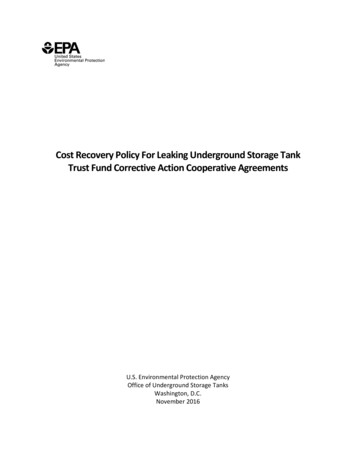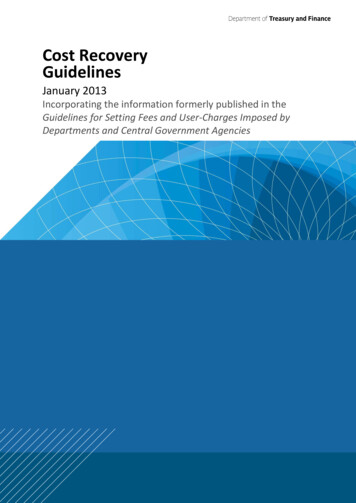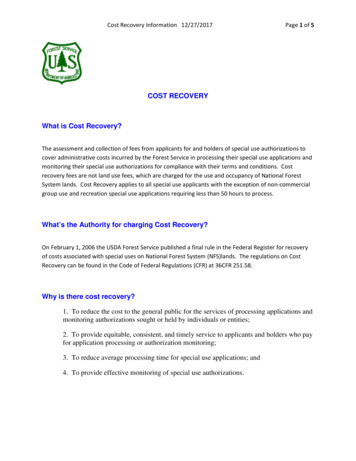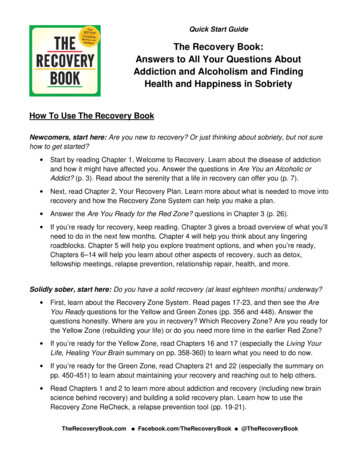
Transcription
Cost Recovery Policy For Leaking Underground Storage TankTrust Fund Corrective Action Cooperative AgreementsU.S. Environmental Protection AgencyOffice of Underground Storage TanksWashington, D.C.November 2016
This page intentionally left blank.
ContentsIntroduction . 1State LUST Trust Fund Cost Recovery Programs . 2Autonomy And Discretion . 2Recoverable LUST Trust Fund Expenditures . 3Interest . 3Requirements And Responsibilities . 4Cost Recovery Authority . 4Cost Recovery Policy Or Procedures . 4Priority Systems For Cost Recovery Cases . 4Notifying Owners And Operators And Demanding Payment . 5Timely Processing: Statute Of Limitations . 5Documenting Costs . 6Preparing The Cost Recovery Package . 7Site File Establishment . 8Notifying And Reporting To EPA . 10Retaining Cost Recovered LTF Money . 10Documenting Cost Recovery Decisions And Case Closure . 11Considerations For Different Scenarios . 12Solvent Owner Or Operator . 12Ability To Pay (ATP) . 12Owner Or Operator Fails To Maintain Financial Responsibility . 13Recalcitrant (Unwilling) Owner Or Operator . 13Insolvent (Unable To Pay) Owner Or Operator. 13Municipalities That Have Involuntarily Acquired Properties . 13Releases Caused By Natural Disasters . 13EPA’s Role In State Cost Recovery Of LUST Trust Funds . 15Solid Waste Disposal Act (SWDA) § 9003(h)(6), Recovery Of Costs . 16i
This page intentionally left blank.ii
IntroductionCost recovery is a legal process that states or the United States Environmental Protection Agency (EPA)undertake to recover from underground storage tank (UST) owners or operators the costs related topetroleum releases at leaking underground storage tank (LUST) sites. Recoverable costs include thosepaid through the LUST Trust Fund for corrective action, enforcement (including oversight), programadministration, and interest on those costs 1.Recovering LUST Trust Fund (LTF) money may provide an incentive for: UST owners or operators to clean up releases from their own tanksUST owners or operators to comply with technical and financial responsibility requirementsStates to pursue recoveries efficiently because they may retain recovered LTF money to use foradditional LTF eligible cleanups and activitiesThis document: Identifies requirements, objectives, and responsibilities for LTF cost recovery under state LTFcorrective action cooperative agreementsIs a companion document to EPA’s Leaking Underground Storage Tank Trust Fund CorrectiveAction Cooperative Agreement Guidelines (LTF Guidelines)Replaces the 1994 Cost Recovery Policy For The Leaking Underground Storage Tank Trust Fundand the 1989 LUST Trust Fund State Financial Management HandbookSee EPA’s Leaking Underground Storage Tank Trust Fund Corrective Action Cooperative Agreement Guidelines formore information about these cost categories.11
State LUST Trust Fund Cost Recovery ProgramsEPA expects owners or operators to conduct the majority of UST cleanups. However, when states spendLTF money, EPA expects states to make reasonable efforts to recover LTF costs from owners oroperators.Autonomy And DiscretionStates implement the cost recovery program, have discretion operating it, and benefit directly fromtheir successful recoveries.States have the autonomy and discretion to: Litigate and settle cost recovery cases:o Use the authority provided in SWDA § 9003(h)(6) [U.S. Code 42 6991b(h)(6)] to litigate andsettle claims without EPA’s or the U.S. Department of Justice’s routine involvement orconcurrence 2o Settle cost recovery litigation as part of the exercise of enforcement discretion conveyed bySWDA § 9003(h)o Settle cost recovery claims administratively 3o Compromise or terminate LTF cost recovery claimsDetermine:o Under what circumstances they will pursue costso Which costs to pursueo How much effort to devote in pursuit of costsStates are encouraged to tailor procedures to: Suit their individual programsSave program resourcesUse cost recovery resources appropriately and efficiently2Under 28 U.S.C §516, the Department of Justice must conduct any litigation in which the United States has aninterest unless there is an exception authorized by law. EPA interprets SWDA § 9003(h) to be such an exception,allowing states with cooperative agreements that have the capabilities to carry out effective corrective actions andenforcement activities to exercise various program authorities, including the cost recovery authority provided inSWDA § 9003(h)(6).3EPA interpreted SWDA § 9003(h) authority to include the ability to administratively settle claims and tocompromise or terminate LUST Trust Fund claims based on considerations of equity as described in SWDA §9003(h)(6)(B). In this document, the term compromise means accepting less than the full value of the claim andtermination means forgoing any cost recovery whatsoever.2
Recoverable LUST Trust Fund ExpendituresPursuing cost recovery for all categories of state LTF expenditures gives states an advantage to reachagreements with owners or operators. However, states are not required to pursue cost recovery of allLTF expenditures (such as, recovery of negligible expenditures, program administration costs, or indirectcosts). EPA also expects that states will exercise discretion in determining an appropriate level of effortto devote to pursuing enforcement costs. Generally, the costs of enforcement, including oversight, arecomparatively low and the number of cases is very large. Where owners or operators perform cleanups,states may choose not to pursue recovery of enforcement costs. This may encourage owners oroperators to take corrective action at their sites.Owners and operators are liable for all LTF expenditures made by states and interest. For informationabout site corrective action, enforcement, oversight, and program administration costs, see the LTFGuidelines, Categories of Cost, page 5. For interest costs, see below:InterestOwners or operators are liable for interest charges on LTF expenditures at their sites. Assessing interestcan: Deter owners or operators from postponing payment Provide incentives for owners or operators to settle cost recovery claimsStates should assess and are encouraged to pursue interest 4 on recoverable LTF corrective action andenforcement expenditures. United States Department of Treasury’s, Bureau of the Fiscal Servicepublishes the minimum recommended rate of interest that states should assess OvernightRateDate.htm). States may assess a higherrate of interest if state law authorizes it. The rate of interest should remain fixed for the duration of theindebtedness, except where the owner or operator has defaulted on a repayment agreement and seeksto enter into a new agreement. New agreements should reflect the current value of funds to the U.S.Treasury unless state law requires otherwise. States are allowed to compound interest.Before assessing interest, states should notify the owner or operator through a demand letter explainingthe requirements concerning the debt and the interest. Interest accrues from the date the demandletter is sent or hand-delivered to the owner or operator. Interest should not be charged if the amountdue is paid within 30 days after the notice was postmarked or delivered to the owner or operator.States may decide, on a case-by-case basis, to extend the thirty-day period.As part of their responsibility for settling claims, states may elect not to pursue all or part of thecollection of interest, to the extent permitted by state law. For example, state law may allow state USTprograms to forgo collection of interest if the owner or operator is in financial distress, or if the cost ofcollecting the interest will be more than the amount potentially collected.4SWDA § 9003(h) describes the states’ role in recovering LTF expenditures but does not specifically address thecollection of interest on those expenditures. EPA is entitled under the Debt Collection Act of 1982, as amendedby the Debt Collection Improvement Act of 1996 (31 U.S.C. 3701, et seq), and common law authorities to collectinterest on recoveries of Trust Fund expenditures. Since states also have responsibility for recovering LTFexpenditures under SWDA § 9003(h), they should also assess and may pursue interest on recoverable costs.3
Requirements And ResponsibilitiesStates are responsible for all legal, programmatic, and administrative activities necessary to recover LTFexpenditures. EPA expects states to adequately fund and staff cost recovery caseloads and to discusscost recovery actions with EPA’s regional UST program as part of program reviews.Cost Recovery AuthorityStates must have either state authority to recover LTF expenditures, or a state law that permits it toexercise the cost recovery authorities under the Solid Waste Disposal Act (SWDA) of 1976 (commonlyknown as the Resource Conservation and Recovery Act (RCRA)) as amended § 9003(h)(6) [42 US §6991b(h)6]. States with their own recovery authorities should also cite SWDA Subtitle I in their recoveryactions to establish the liability of owners or operators to the federal government for LTF expenditures.For more information on state authority, see LTF Guidelines: LTF Cooperative Agreement Requirements:Authority And Capability, page 18.Cost Recovery Policy Or ProceduresStates must have a cost recovery policy or procedures consistent with those outlined in this document.These policies or procedures should provide a framework for consistent state cost recovery programdecisions. States must submit their written cost recovery policies or procedures to EPA upon request.Although states have the discretion to decide which costs to pursue on a case-by-case basis, statesshould articulate their overall approach to cost recovery including a rationale for not pursuing certaincosts. For example, states may elect not to pursue oversight costs associated with cooperative owner oroperator-lead cleanups.Priority Systems For Cost Recovery CasesStates should have a system to set priorities for cost recovery cases but have considerable discretion inprioritizing and determining an appropriate level of effort for each case. Under the Energy Policy Act of2005, Congress required EPA and states to consider UST owners or operators ability to pay (ATP) whendetermining the level of cost recovery effort and the amount to be recovered. When setting priorities,states should also consider: Cost of cleanupLikelihood of recoveryDeterrent value of the caseOpportunity costs (resources the state could use pursuing other cases)Whether the owner or operator is in compliance with financial responsibility requirementsWhether the owner or operator is cooperativeWhether the owner or operator was negligent in allowing the release to occurWhether the owner or operator is deceased and has an estateResources needed to undertake cost recoveryStatute of limitations4
States should aggressively pursue cost recovery cases when owners or operators: Are solvent and recalcitrantFail to comply with applicable financial responsibility requirementStates should weigh the resources necessary to recover the claim against the amount they may recover.States should generally commit fewer resources to cost recovery when owners or operators areinsolvent or financially distressed. However, states should make reasonable efforts to locate a liableowner or operator before assigning a low priority to these cases.Notifying Owners And Operators And Demanding PaymentWhen states use the LTF for corrective action, states should: Search for owners or operators 5Make reasonable efforts to contact owners or operators who are liable for releasesIf identified, notify owners or operators of their liability for corrective action and enforcementcost, and demand paymentStates must follow state law to notify the owner or operator through a written notice or demand letterwith the amount of funds they intend to recover. When demanding payment, EPA expects states topursue corrective action costs, enforcement costs, and interest. States should ensure that any letter orother official notice to the owner or operator includes the amount due, payment schedule, and interestrate.States would not issue a demand letter when: The owner or operator is unknownStates determine that the owner or operator is insolventStates decide not to pursue oversight costs, for example, wheno The owner or operator pays for cleanupo An alternative mechanism exists, such as a state financial assurance fund, to pay forcorrective actionTimely Processing: Statute Of LimitationsStates are responsible for timely processing of cost recovery cases in order to increase the chances ofsuccessful recovery.States should pursue cost recovery so as not to exceed any statute of limitations or other legallimitation. They should revise their priorities for individual cost recovery cases as statute of limitationdeadlines approach. For states relying solely on SWDA 9003(h)(6) cost recovery authority, the statute oflimitations is six years. However, EPA recommends pursuing cost recovery within three years if5For more information on searching for responsible UST owners or operators, see: EPA’s Responsible Party SearchGuide For The Underground Storage Tank Program5
possible. 6 If states have authority under state law to support LTF cost recovery action, then the statesstatute of limitations would apply even if it is longer than the federal statute of limitations. Statesshould not allow the statute of limitations to run out and justify case closure solely on that basis.Where the program is dependent on the state Attorney General’s Office (AGO) to pursue cost recovery,states should consider formal funding arrangements with the AGO (for example, a memorandum ofagreement to ensure legal staffing for cost recovery referrals).States may refer cost recovery cases to EPA when additional support may be needed, for example whencases: Are complicatedAre resource intensiveInvolve large sums of moneyCross state jurisdictions; orWhen EPA and the state pursue corrective action jointlyDocumenting CostsTo pursue cost recovery actions effectively, states must be able to provide documents that prove the: Owner or operator is liable under federal or state lawWork performed was reasonable and necessaryExpenditures were documented accuratelyStates must document all site-specific LTF expenditures (see: LTF Guidelines, Accounting andDocumentation, page 24), delineating both direct and indirect costs. Documentation should also includedetails about how the state derived subtotals for direct and indirect costs.No one approach to cost documentation is applicable to all states. Therefore, upon request, statesshould inform EPA about their cost accounting, documentation, and recordkeeping systems. Somestates have policies where they do not use LTF money for any site with a responsible owner or operatortherefore negating the need to recover payments from a liable owner or operator or document thesecosts.6SWDA does not contain a specific statute of limitations provision. However, EPA believes that the relevant federalstatute of limitations provision for a LUST cost recovery claim under SWDA 9003(h)(6) is the six year statute oflimitations period found in 28 U.S.C. § 2415(a), which provides in relevant part: every action for money damages brought by the United States or an officer or agency thereof which isfounded upon any contract express or implied in law or fact, shall be barred unless the complaint is filedwithin six years after the right of action accrues .EPA believes that a SWDA 9003(h)(6) LUST cost recovery claim is a claim for money damages based on a“contract,” (which has a six year statute of limitations), and not based on a tort (which has a three yearstatute of limitations).6
Preparing The Cost Recovery PackageCost recovery package preparation begins when the state program office decides to initiate a costrecovery action and requests staff responsible for recordkeeping and accounting to prepare a costsummary for the site. The summary, placed in the front of the cost recovery package, should identifycosts by category (salaries, travel, supplies and equipment, etc.). Each category should containsupporting documentation obtained from both site files and the state accounting system. A criticalaspect of cost documentation preparation is reconciliation of cost information pulled from both sources.States should not forward a cost summary to the legal office until the figures obtained from site files andthe accounting systems agree.At a minimum, each document in the cost document package should demonstrate that: Cost are properly chargedSite-specific identifier and account number agree with the site nameTimesheets indicate appropriate information to identify employees, hours, and account numbersAccount numbers and costs are recorded in states accounting systemsTravelers charged appropriate travel time to the site, particularly when they have visited one ormore sitesContractor invoices reference the specific siteStates should ensure that documents submitted as evidence are authentic, reliable, complete, andaccurate. States should: Produce receipts showing expenses incurredBe prepared to provide an expert witness to testify to the document's authenticity and reliabilityBe able to discuss full cost accounting such as the indirect cost and accounting methodologiesused to track costsHave timesheets that reflect the timeframe in which the state performed the workStates should comply with appropriate privacy act requirements for redacting; a process by whichsensitive information contained in the documents is removed.States should consider appointing a cost recovery coordinator to assist during the cost recovery phase.The function of the coordinator is to track anticipated actions and progress as well as to review costdocumentation packages for completeness before forwarding to the state's legal staff.7
Site File EstablishmentStates are required to maintain documentation and appropriate records to support cost recovery.Maintaining files with all pertinent documents for each site is an effective, simple way to access expenserecords quickly. States may develop their own recordkeeping systems. However, states shouldestablish unique site-specific identifiers or codes along with corresponding site-specific files. Statesshould also develop a filing protocol to ensure that they file documents in a consistent order.In developing a site-specific recordkeeping system, states should consider: Staff availability for collecting and filing recordsAbility to access original documents 7Ability to access records quicklyAbility to match documents with corresponding cost dataDocument protectionProcedures for safe long-term documentation storageThe chart on page 9 lists the documents that states should retain for cost recovery purposes.Electronic, open, machine-readable information is preferable to paper, as long as there are appropriate andreasonable internal controls in place to safeguard against any inappropriate alteration of records.78
Recommended Documents For RetentionCost CategoryPayrollKeep In Site Files Keep But Not Necessarily In Site Files Time attendance recordsTime attendance amendmentsWorksheet showing fringe benefitcalculations (if not calculated byaccounting system)Authorizations (including purpose oftrip)Vouchers showing:o Starting point and destinationo Transportation methodo Number and names of persons ontripReceipts (airlines, hotel, rental car, etc.)Proof of paymentTrip reportsContractor invoicesProject officer approval of invoicesProof of payment InvoicesProof of paymentHourly records of equipment useProgramAdministrationCostsIndirect Costs Worksheets showing calculations, ifappropriate ProposalContractor cost data (EPA Form5700-41)Cost price analysis of proposalProposal evaluationsContractReports on contractor workAudits of contractorTypes of materials and suppliesfurnishedTypes of equipmentContractsLeasesPurchase ordersReceiving reportsExplanation of usage ratecalculationAllocation methodRate calculation Worksheets showing calculations if notcalculated by accounting systems Rate agreementRate documentation packageOther Audit reportsFinancial transactions Cooperative agreement andamendmentsStaff Travel ContractorServicesEquipment andSupplies9 Position titles of staffSalary of staff (annual or hourlyrate)Methodology for determining fringebenefit rate
Notifying And Reporting To EPAIf the cost recovery effort proceeds to judicial action, states should notify EPA’s regional UST ProgramManager to determine whether the action may affect the scope of the SWDA Subtitle I authorities.If a settlement is reached, as required by 2 CFR § 200.327 and the cooperative agreement’s terms andconditions, states must report to EPA: Settlement amountAmount receivedDate of receipt of paymentStates must also document and file any cost recovered money received from the owner or operator,agreed to, or adjudged owed by the owner or operator, as a settlement for site corrective action.Retaining Cost Recovered LTF MoneyIn accordance with 2 CFR § 200.307(e)(2), when states make successful cost recoveries, they may retainthe recovered LTF share, including interest, as program income and use the money for additional LTFeligible and allowable costs. Program income is, in effect, reimbursement for LTF corrective action,enforcement, oversight, and program administration costs.When states retain recovered LTFs, they must: Use recovered money for allowable and eligible activitiesTrack accounts receivedMaintain appropriate accounting of recovered fundsDocument appropriate use in accordance with 2 CFR § 200.305(b)(5) and 2 CFR § 1500.7 and 2CFR § 200.307 and applicable requirements of the cooperative agreementsAlternatively, states may return recovered money to the U.S. Department of Treasury throughcoordination with EPA. However, EPA does not have access to this money from the Treasury unlessCongress appropriates LTF money to EPA. Therefore, EPA recommends states retain cost-recoveredmoney for use under the cooperative agreement. When negotiating their cooperative agreements,states and EPA should develop contingency plans that allow states to obligate their recoveriesefficiently.States should calculate the LTF portion (this may include state matching funds under the cooperativeagreement) of their total recoveries on a site-by-site, pro rata basis. For example, if a state spends 50,000 of LTF cooperative agreement money at a site and the state ultimately recovers 50 percent ofall LTF money used at the site, it must redirect 25,000 as program income to use for LTF eligibleactivities and allowable costs.States may not use recovered, including the recovered state match contribution under the cooperativeagreement, to meet their ten percent cost share requirement. However, states may consider the costsof legal staffing as in-kind contributions toward satisfying their ten percent cost share (match)requirements under 2 CFR § 200.306 if LTF money was not used to pay for these legal services.10
Documenting Cost Recovery Decisions And Case ClosureEPA encourages states to make decisions that are in the best interest of their programs, reflect efficientuse of LTF money, and stimulate compliance by owners or operators. However, states must documentthe reasons for their decisions and maintain adequate documentation for audit and cost recoverypurposes. States must document cost recovery decisions by site.In cases where equitable factors or the efficient use of resources supports compromise or termination ofa cost recovery action, states must document the basis for any LTF compromise or termination. Thisdocumentation should be adequately supported in state records and reflect the efficient use of LTFresources. For example, when: An owner or operator demonstrates the lack of financial resources to pay the claimThe likelihood of success litigating the claim is small because of the absences of proof of liabilityor unavailability of required witnesses; orCosts of judicial collection are disproportionately highRegardless of the action taken by states in exercising their discretion in cost recovery cases, states mustdocument fully their decisions and formally close out all cases. The documentation need not beextensive, but the rationale for states decision needs to be clearly presented and consistent with theircost recovery policies. Reasons for case closure include situations where costs of pursuing a case furtherwill approach or exceed the potential recovery, or cause bankruptcy of the owner or operator.States must also document reasons for not pursuing cost recovery, for example, if the owner oroperator cannot be found or is deceased and the estate has insufficient assets.States must maintain original cost documentation records 8 for at least six years (consistent with the LTFcost recovery statute of limitations, see page 5) from the final expenditure report (Federal FinancialReport Standard Form 425) or for the length of time required by the state, whichever is longer: If any litigation, audit, or other action was initiated prior to the expiration of the three-yearperiod, states must retain records until completion of the action and resolution of all issues thatarise from itBefore disposing of any cost documentation, states should consider their relevance to futurecost recovery efforts and the applicable statute of limitationsMust comply with the federal retention and access requirements for records 2 CFR § 200.333through 200.337 and 2 CFR § 1500.6)Electronic, open, machine-readable information is preferable to paper, as long as there are appropriate andreasonable internal controls in place to safeguard against any inappropriate alteration of records.811
Considerations For Different ScenariosSolvent Owner Or OperatorStates should assess owners or operators ability to pay (ATP) when determining whether they can useLTFs and whether cost recovery is feasible. Congress intended that solvent owners or operators takeresponsibility for releases from their underground storage tanks. When states use the LTF for correctiveaction, they should pursue cost recovery from solvent owners or operators. When owners or operatorsclaim inability to pay, states should conduct a preliminary ability to pay analysis and a more detailedanalysis in the cost recovery process 9.Ability To Pay (ATP)EPA has three financial models (ABEL, INDIPAY, and MUNIPAY) that may help states analyze whether theowner or operator has an ATP for corrective action. ABEL - Evaluates a corporation or partnership's ability to afford compliance costs, correctiveaction costs, or civil penaltiesINDIPAY - Evaluates an individual's ability to afford compliance costs, corrective action costs, orcivil penaltiesMUNIPAY - Evaluates a municipality's or regional utility's ability to afford compliance costs,corrective action costs or civil penaltiesStates should view solvency in terms of how much an owner or operator can afford to pay withoutbecoming insolvent. EPA defines owners or operators solvency as the ability to pay financial obligationsas they become due, including the cost of corrective action and cost recovery. States must consider theowners or operators ATP while still maintaining its b
Cost recovery is a legal process that states or the United States Environmental Protection Agency (EPA) undertake to recover from underground storage tank (UST) owners or operators the costs related to petroleum releases at leaking underground storage tank (LUST) sites. Recoverable costs include those










